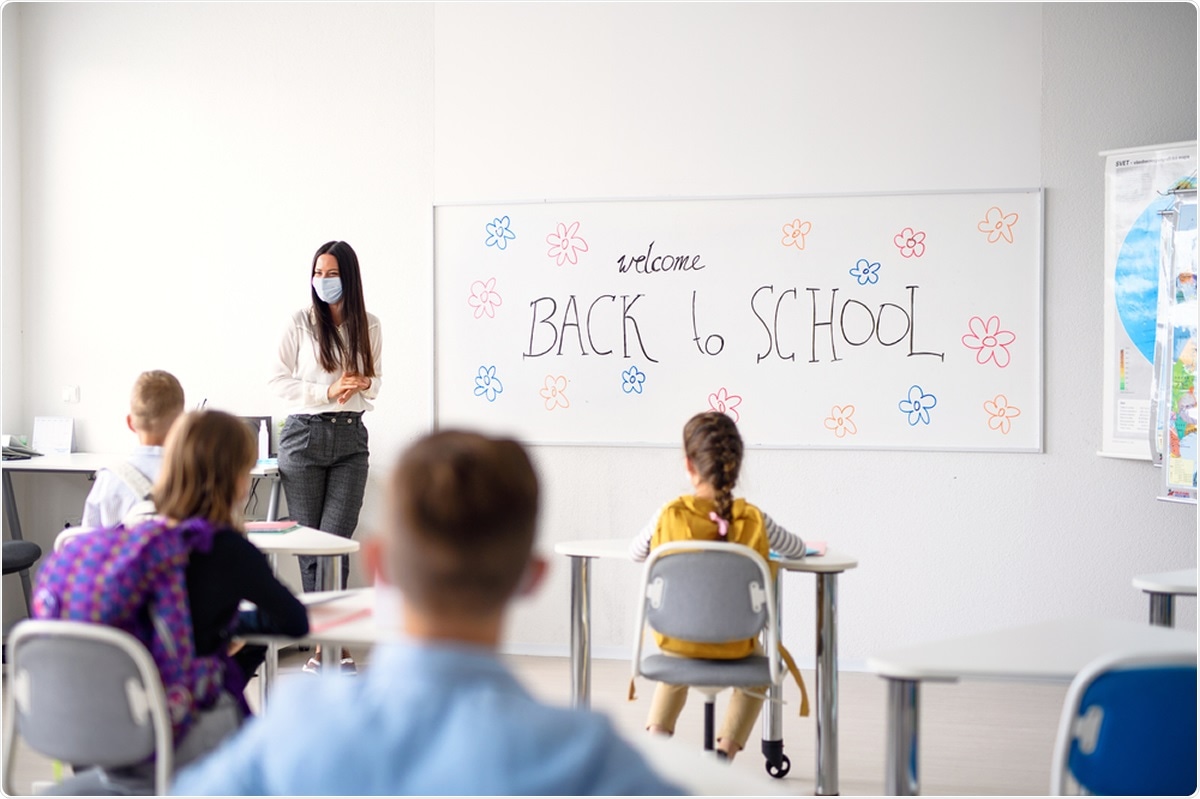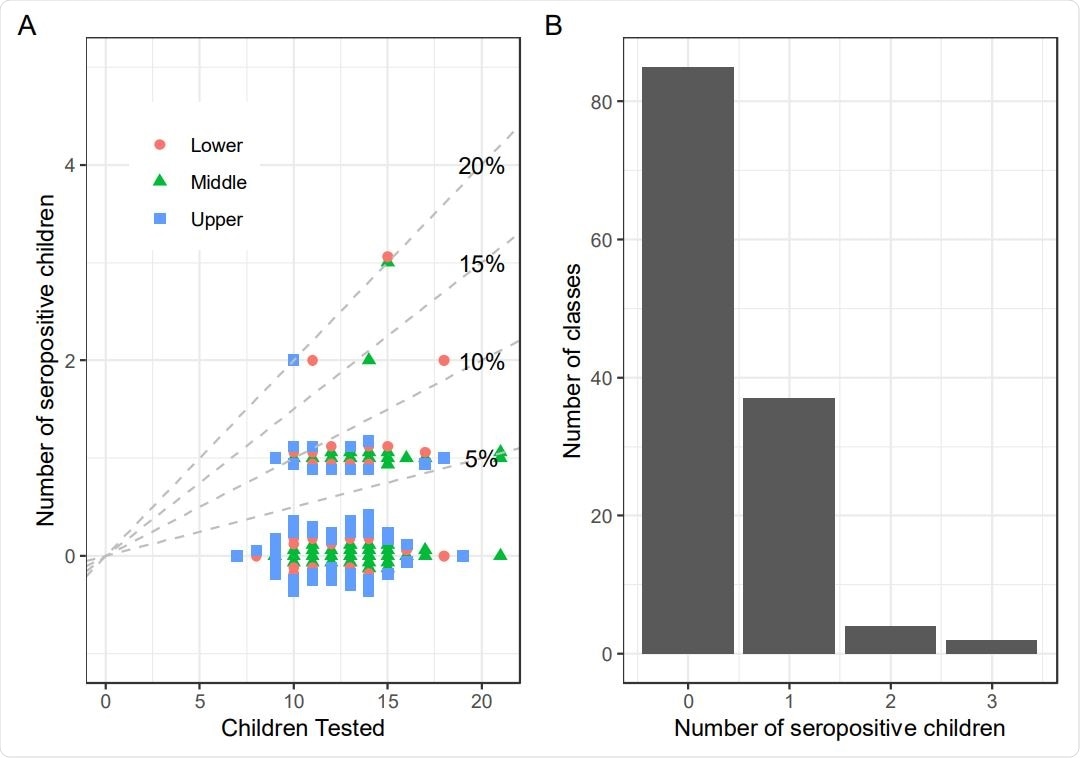The ongoing COVID-19 pandemic is still causing hundreds of thousands of cases in different parts of the world, and resurgences are expected even in places where it is now under control. This has delayed the reopening of schools and workplaces, severely impacting the economy and education.
A new study reports the seroprevalence among schoolchildren in Zurich, Switzerland. Published on the preprint server medRxiv* in September 2020, this study contributes to the current discussion on how and when to reopen schools.

Image Credit: Halfpoint / Shutterstock

 This news article was a review of a preliminary scientific report that had not undergone peer-review at the time of publication. Since its initial publication, the scientific report has now been peer reviewed and accepted for publication in a Scientific Journal. Links to the preliminary and peer-reviewed reports are available in the Sources section at the bottom of this article. View Sources
This news article was a review of a preliminary scientific report that had not undergone peer-review at the time of publication. Since its initial publication, the scientific report has now been peer reviewed and accepted for publication in a Scientific Journal. Links to the preliminary and peer-reviewed reports are available in the Sources section at the bottom of this article. View Sources
Do Schoolchildren Spread the Virus?
The fact that most countries closed their schools in the rising phase of the pandemic made it difficult to directly measure viral transmission among schoolchildren and their teachers as well as other school staff. The reported incidents of outbreaks in school and camps may be outliers, though they could equally well be just the tip of the iceberg of transmission among children.
The current study has a cross-sectional design and aims to measure the seroprevalence of SARS-CoV-2 in some schools in Zurich, Switzerland, as well as its variation within different districts, schools, grades, and classes. They also tried to identify case clusters within classes.
The researchers also explored the link, if any, between (self-reported) symptomatic infection and seroprevalence. The schools and classes measured were selected at random. All participating children were enrolled in the study between June 16 and July 9, 2020. This was after the schools had reopened on May 10, having been closed from March 16, 2020, onwards.

Clustering of seropositive children in classes. Only classes where at least 5 children and at least 50% of the class were tested are shown.
Similar Seroprevalence in Children and Adults
The study included 55 schools, with 2,585 children aged 6-16 years old, in grades from 1-2, 4-5, and 7-8. About 1,300 were girls. The median age was 11 years. The researchers used a Luminex-based antibody test from Corona Immunitas, which detects four antigen targets for each antibody class, namely, IgG, IgA, and IgM.
The researchers found 74 seropositive children, for a seroprevalence of about 2.8%, overall, though it covered the range from 1% to 4.5% depending on the district. The highest seroprevalence was in grades 4-5 and 1-2, at 4.2% and 3.8%, respectively. The lowest seroprevalence of 1.5% was in grades 7-8. Both girls and boys were equally affected.
Thus, the overall seroprevalence in children is similar to the 3.1% seen in randomly screened adults in the same region in the same period, using the same serologic assay for both IgG and IgA antibodies. However, the dark number was 89 in children, vs. only 12 in adults.
Large Dark Number in Children
Simultaneously, the prevalence of PCR-confirmed cases in adults and children was 0.03% and 0.24%, respectively. That is, there were ~90 times more seropositive in children than the number of confirmed infections. In contrast, in adults, the number of total infections was about 12 times the confirmed infection number by PCR. However, the researchers point out that this dramatic increase in dark number in children could be because the symptoms attributed to COVID-19 are already widespread in many childhood illnesses, and thus fail to distinguish seropositivity in this age group.
A Third of Classes Have One Case at Least
One or more cases were identified in 36/55 tested schools. Class-wise, at least one case was detected in 43/128 classes in which more than half the students participated, and in which there were five or more children.
If all classes are pooled, about a quarter of classes had at least one case. On the other hand, if only classes with 15 or more children, with 60% or more of the children undergoing testing, are included, it is found that almost half of the classes have one or more positive children.
Implications
The researchers say, “The results so far do not suggest substantial transmission within schools.”
During this period, no school outbreaks were reported in Zurich. However, the study shows that a third of classes and over half of schools that underwent testing had one or more seropositive cases. However, almost all the classes had only one case.
However, they point out that the seroprevalence is, surprisingly, a little higher in younger children than in older children, though in symptomatic pediatric infections, older children are reported to be affected at a higher rate in earlier studies. This could be because socially distanced interactions are impossible among smaller children, or because they have an immature immune system.
At the same time, children are mostly underdiagnosed, with only 1 in 90 actually being picked up by PCR testing. Health authorities are typically hesitant to do swab tests in children, and the symptoms of COVID-19 in children are highly non-specific, thus contributing to the high dark number. In fact, 3 of 4 children had one or more symptoms that could or could not be due to an underlying SARS-CoV-2 infection. These were not more common in the group of seropositive alone.
While public health policies containing the possible viral spread in schools is a subject of intense controversy, the evidence is lacking on either side. Some case series and individual school studies show a low rate of secondary spread in most cases. However, most seroprevalence studies have focused on households or the population at large.
The seroprevalence in this study reflects the infections occurring from the beginning of the pandemic to the end of May 2020, since this period is required for SARS-CoV-2 antibodies to form. This corresponds to four months of community infection and two months of school closure with a mild level of lockdown.
“The present study is thus unique,” comment the researchers, “as one of the first major studies reporting variation in seroprevalence in children from randomly selected schools in a country where the general lockdown on a population level was mild and short (one month), and school closure lasted only for two months.”
They say that further testing of both parents and school staff/teachers will help understand how the virus is spreading in schools and the community outside.

 This news article was a review of a preliminary scientific report that had not undergone peer-review at the time of publication. Since its initial publication, the scientific report has now been peer reviewed and accepted for publication in a Scientific Journal. Links to the preliminary and peer-reviewed reports are available in the Sources section at the bottom of this article. View Sources
This news article was a review of a preliminary scientific report that had not undergone peer-review at the time of publication. Since its initial publication, the scientific report has now been peer reviewed and accepted for publication in a Scientific Journal. Links to the preliminary and peer-reviewed reports are available in the Sources section at the bottom of this article. View Sources
Journal references:
- Preliminary scientific report.
Ulyte, A. et al. (2020). Variation in SARS-CoV-2 Seroprevalence In School-Children Across Districts, Schools and Classes. medRxiv preprint. doi: https://doi.org/10.1101/2020.09.18.20191254 https://www.medrxiv.org/content/10.1101/2020.09.18.20191254v1
- Peer reviewed and published scientific report.
Ulyte, Agne, Thomas Radtke, Irene Alma Abela, Sarah R. Haile, Jacob Blankenberger, Ruedi Jung, Celine Capelli, et al. 2021. “Variation in SARS-CoV-2 Seroprevalence across Districts, Schools and Classes: Baseline Measurements from a Cohort of Primary and Secondary School Children in Switzerland.” BMJ Open 11 (7): e047483. https://doi.org/10.1136/bmjopen-2020-047483. https://bmjopen.bmj.com/content/11/7/e047483.